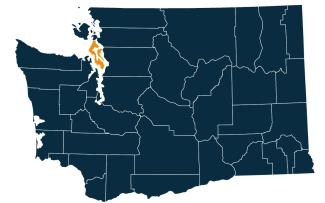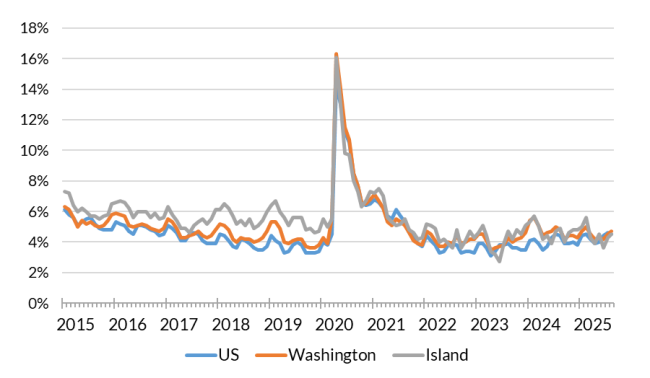- Posted October 2025
August 2025 highlights
Since July, the not seasonally adjusted unemployment rate increased from 4.3% to 4.5% and total nonfarm employment decreased by 120 jobs.
Summary
Total nonfarm employment was estimated at 19,010 jobs in August 2025. This is up 120 jobs compared to July 2025 and 90 above August 2024. The unemployment rate in Island County increased over the month from 4.3% to 4.5%. The size of the labor force at 35,496 increased by 722 workers over the month. There were approximately 141 initial claim filings for unemployment insurance as compared to July 2025.
Geography

Island County is situated in the Salish Sea in northwest Washington. As its name suggests, it is made up of several islands. The two largest are Whidbey and Camano. Island County is the second smallest county in Washington by landmass, just larger than neighboring San Juan County. Island County is bounded to the north by Deception Pass and to the south by Puget Sound. Skagit Bay and Saratoga Passage are located to the east and Admiralty Inlet and the Strait of Juan de Fuca are west. Skagit and Snohomish counties lie to the east of Island County and the Olympic Peninsula lies across the water to the west.
Island County is one of six counties included in the Seattle-Tacoma Consolidated Metropolitan Statistical Area (CMSA).
The largest employer is U.S. Naval Air Station Whidbey Island in Oak Harbor. Oak Harbor is the largest city in the county.
Island County is part of the Northwest Workforce Development Area. Visit the Workforce Training & Education Coordinating Board website for information about the 12 regions.
Employment situation for August 2025
Labor force and unemployment
- The not seasonally adjusted unemployment rate was 4.5% in August 2025, up from 4.3% in July 2025 and below 4.9% in August 2024.
- The labor force in August 2025 was 35,496 workers, 73 more workers than August 2024 and 722 more workers than July 2025.
Unemployment rate, not seasonally adjusted

Source: Employment Security Department/Labor Market Information and Research Division, Local area unemployment statistics
Payroll employment
- Total nonfarm employment increased by 120 jobs from July, bringing the estimated job count to 19,010 jobs. The figure is 90 jobs above August 2024.
- Construction employment was up 10 jobs over the month and was 80 jobs below last year.
- Retail trade lost 40 jobs over the month and was 90 jobs below last year.
- Professional and business services jobs gained 10 jobs over the month and was 70 jobs above last year.
- Private education and health services added 30 jobs over the month and was 230 jobs above last year.
- Leisure and hospitality added 40 jobs over the month and was 50 jobs below last year.
Nonfarm employment estimates, not seasonally adjusted, Island County
| NAICS Industry Title | Aug 2025 (Prelim) | Jul 2025 (Revised) | Aug 2024 (Revised) | Jul 2025 to Aug 2025 Change | Aug 2024 to Aug 2025 Change | Aug 2024 to Aug 2025 % Change |
|---|---|---|---|---|---|---|
| Total nonfarm | 19,010 | 18,890 | 18,920 | 120 | 90 | 0.5% |
| Total private (total nonfarm less government) | 14,210 | 14,130 | 14,090 | 80 | 120 | 0.9% |
| Goods-producing | 1,930 | 1,910 | 2,010 | 20 | -80 | -4.0% |
| - Mining and logging | 10 | 10 | 10 | 0 | 0 | 0.0% |
| - Construction | 1,240 | 1,230 | 1,320 | 10 | -80 | -6.1% |
| - Manufacturing | 680 | 670 | 680 | 10 | 0 | 0.0% |
| Service-providing | 17,080 | 16,980 | 16,900 | 100 | 180 | 1.1% |
| - Wholesale trade | 270 | 280 | 270 | -10 | 0 | 0.0% |
| - Retail trade | 2,140 | 2,180 | 2,230 | -40 | -90 | -4.0% |
| - Transportation, warehousing, and utilities | 260 | 260 | 250 | 0 | 10 | 4.0% |
| - Information | 250 | 240 | 250 | 10 | 0 | 0.0% |
| - Financial activities | 710 | 700 | 700 | 10 | 10 | 1.4% |
| - Professional and business services | 1,900 | 1,890 | 1,830 | 10 | 70 | 3.8% |
| - Private education and health services | 3,010 | 2,980 | 2,780 | 30 | 230 | 8.3% |
| - Leisure and hospitality | 2,760 | 2,720 | 2,810 | 40 | -50 | -1.8% |
| - Other services | 980 | 970 | 970 | 10 | 10 | 1.0% |
| - Government | 4,800 | 4,760 | 4,820 | 40 | -20 | -0.4% |
Note: Data benchmarked through March 2025, updated September 15, 2025.
Source: Employment Security Department/Labor Market Information and Research Division, Washington employment estimates (WA-QB & CES)
Detailed tables can be found on the source page in the third spreadsheet titled Current employment estimates, not seasonally adjusted.
Industry employment (covered employment)
Employment by industry, Island County 2024 annual average

Note: ND stands for not disclosed. ND is used to avoid disclosing data for individual employers. Industries labeled ND are grouped in the Not elsewhere classified category.
Source: Employment Security Department/Labor Market Information and Research Division, Covered Employment (QCEW)
Average annual covered employment in Island County was 18,271 in 2024. Covered employment refers to workers who received wages in Washington state and are eligible for state and federal unemployment insurance (UI) compensation programs.
The average annual wage in Washington state for all industries was $92,467 in 2024. The average annual wage in Island County was $58,930 in 2024.
Top sectors in terms of average annual employment in 2024:
- Government (4,725)
- Accommodation and food services (2,269)
- Retail trade (2,200)
- Health care and social assistance (2,122)
- Construction (1,260)
The top sectors in terms of annual average wages in 2024:
- Professional, scientific and technical ($1124,267)
- Finance and insurance ($121,588)
- Not elsewhere classified ($102,683)
- Information ($92,992)
- Wholesale trade ($77,199)
Workforce demographics in Island County
Age
| Demographic characteristic | Total | Labor force participation rate | Unemployment rate |
|---|---|---|---|
| Population 16 years and over | 73,254 | 57.0% | 4.7% |
| 16 to 19 years | 3,479 | 46.5% | 22.8% |
| 20 to 24 years | 5,779 | 91.2% | 11.9% |
| 25 to 29 years | 5,632 | 80.5% | 3.1% |
| 30 to 34 years | 5,445 | 82.9% | 3.6% |
| 35 to 44 years | 10,114 | 82.6% | 4.6% |
| 45 to 54 years | 8,285 | 81.7% | 3.1% |
| 55 to 59 years | 5,106 | 75.2% | 2.6% |
| 60 to 64 years | 6,774 | 49.7% | 3.0% |
| 65 to 74 years | 13,659 | 19.5% | 1.5% |
| 75 years and over | 8,981 | 8.9% | 0.0% |
Race or Hispanic origin
| Demographic characteristic | Total | Labor force participation rate | Unemployment rate |
|---|---|---|---|
| White alone | 59,206 | 54.6% | 4.7% |
| Black or African American alone | 2,014 | 76.8% | 5.2% |
| American Indian and Alaska Native alone | 717 | 71.5% | 3.8% |
| Asian alone | 3,777 | 62.9% | 5.7% |
| Native Hawaiian and other Pacific Islander alone | 281 | 91.1% | 0.0% |
| Some other race alone | 1,467 | 78.5% | 2.4% |
| Two or more races | 5,792 | 61.3% | 4.0% |
| Hispanic or Latino origin (of any race) | 5,209 | 75.8% | 6.6% |
| White alone, not Hispanic or Latino | 57,586 | 53.9% | 4.4% |
| Population 20 to 64 years | 47,135 | 77.8% | 4.3% |
Sex
| Demographic characteristic | Total | Labor force participation rate | Unemployment rate |
|---|---|---|---|
| Male | 24,351 | 84.9% | 4.6% |
| Female | 22,784 | 70.2% | 3.9% |
Females with children
| Demographic characteristic | Total | Labor force participation rate | Unemployment rate |
|---|---|---|---|
| With own children under 18 | 7,543 | 68.8% | 2.1% |
| With own children under 6 only | 2,419 | 68.6% | 4.5% |
| With own children under 6 and 6 to 17 | 1,787 | 64.7% | 0.9% |
| With own children 6 to 17 only | 3,337 | 71.1% | 1.3% |
Poverty status in the past 12 months
| Demographic characteristic | Total | Labor force participation rate | Unemployment rate |
|---|---|---|---|
| Below poverty level | 3,314 | 35.6% | 11.3% |
| At or above the poverty level | 41,866 | 80.3% | 4.0% |
Disability status
| Demographic characteristic | Total | Labor force participation rate | Unemployment rate |
|---|---|---|---|
| With any disability | 5,632 | 54.2% | 5.2% |
Educational attainment
| Demographic characteristic | Total | Labor force participation rate | Unemployment rate |
|---|---|---|---|
| Population 25 to 64 years | 41,356 | 75.9% | 3.5% |
| Less than high school graduate | 1,946 | 61.4% | 9.6% |
| High school graduate (includes equivalency) | 10,107 | 76.7% | 3.1% |
| Some college or associate's degree | 16,605 | 73.7% | 3.5% |
| Bachelor's degree or higher | 12,698 | 80.3% | 3.0% |
Source: U.S. Census Bureau, American Community Survey 5-year estimates, S2301 | Employment Status
This workforce product was funded by a grant awarded by the U.S. Department of Labor's Employment and Training Administration. The product was created by the recipient and does not necessarily reflect the official position of the U.S. Department of Labor. The Department of Labor makes no guarantees, warranties, or assurances of any kind, expressed or implied, with respect to such information, including any information on linked sites and including, but not limited to, accuracy of the information or its completeness, timeliness, usefulness, adequacy, continued availability, or ownership. This product is copyrighted by the institution that created it. Internal use by an organization and/or personal use by an individual for non-commercial purposes is permissible. All other uses require the prior authorization of the copyright owner.


